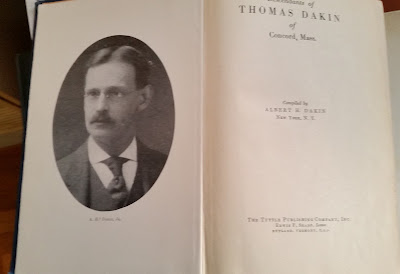For the DAKIN family, we have the 716 page "go to book" written over many years by Albert H Dakin, and published, after he died by his niece, Mrs. H B Yamagata in 1948.
Prior to the internet, I would write letters to town clerks, including the self-addressed stamped envelop (SASE) and a check to cover the cost of sending a birth, marriage or death certificate. Then from that certificate, write more letters for the grand or great grand, etc. parents indicated there -- building the tree piece by piece as I'd learn parents' names of an ancestor. Now with the internet and the availability of some new sources online, I get hints from more than just the birth, marriage and death records -- newspapers, census pages, etc. are full of research clues. But I still send to the town clerks for the vital records for confirmation.
Just imaging Albert H Dakin working on this not just for years but for decades, starting with the original Dakin settler, Thomas, in Concord MA in the 1600s and working down to "his time" of the 1940's. Checking every child, then every child, then every child .... continuing down the generations. WHEW!! 716 pages of ancestors numbering in the thousands! Actually Albert documented 6,843 descendants of Thomas Dakin and also included an every-name index in his book! IMPRESSIVE work.
What else might Albert have done beyond writing town clerks in order to find these 6,843 descendants?
Well, he wrote letters! Lots of letters.
These letters were before the days of email and computers. So every letter was individually typed and contained some information that he already knew and asked for more information for his files.
This letter written to my grandmother in 1943, inquiring about her family. It tells her who referred him to her, a reference to information sent by her husband a year before he died in 1917, and a chart to fill in and correct if anything is incorrect. He is writing this in 1943, worrying about whether he will be able to finish his project -- he died in 1945.
ALBERT H. DAKIN 2064 12-35
977 Anderson Ave.
New York, N.Y.
January 21, 1943
Mrs. Marion E. Dakin,
c/o College,
Storrs, Conn.
Dear Mrs. Dakin:
For many years I have been collecting the genealogical
records of the Dakin Family and am at present writing up my notes
in the final shape. I have not known where to locate you until
yesterday when Mr. Charles R Harte gave me your address. I am
very anxious to bring my notes up to date and am asking your
kind help to secure it.
I am enclosing a blank which shows all the data I have
of your family and which is for the most part data your
husband sent me in 1917.
Will you please add to this enclosed blank any additional
data that may be missing, correct any errors of mine and return
the blank to me.
I believe you had another child that I have no record of.
If either of your children married will you please give me their
address so that I may write to them to bring my notes up to date.
One other question: Is Mr. Dakin’s mother living and
if not can you tell me when and where she died.
I will greatly appreciate receiving an answer from you
as I am anxious to complete my records while I have the ability.
Sincerely yours,
Albert H Dakin
and of course, he enclosed a SASE!
The Chart arrived in the mail in January of 1943 -- a busy time for Marion. Her son Theodore got married that month with the anticipation of being draft by the US Army & shipped out sometime in the next few months; and as the First Extension Nutritionist for the State of Connecticut, Marion was busy preparing Farm and State Bulletins on how to manage with the Rationing for World War 2.
So, did Marion Dakin fill out the chart?
Sure looks like she edited incorrect information, added her new daughter-in-law, added her son who had died, and added death information for her husband.
So, did she mail it back?
Clearly not this one, since I found it among her paperwork when she died decades later.
Did Albert ask again?
It doesn't look like he did.
After all, I found the envelop sent from Albert to Marion in 1943.
Here is the book entry for her husband's father including his marriage to Marion and the birth of their son Theodore.
It does not any of Theodore's siblings who died young, or the information on Theodore's marriage. Theodore is entry #3596, but there is no separate entry for him later in the book.
The documentation of our family line in the "Dakin book" stops with Theodore's birth.
Marion's not sending the letter back, means that any further information is not included in the Dakin family book.
But the gift Marion gave us by not mailing it back is to show us what our ancestors who documented our families in past decades and generation did in order to put their family histories together.
The link to this page is http://genea-adventures.blogspot.com/2017/01/family-history-research-before.html
©2017, Erica Dakin Voolich










